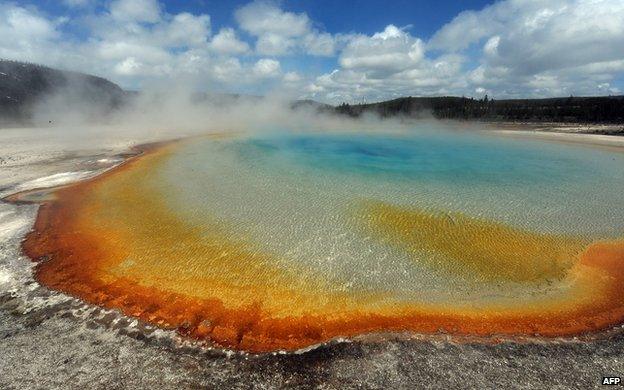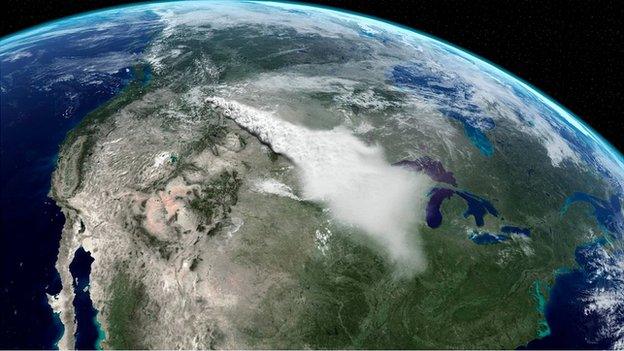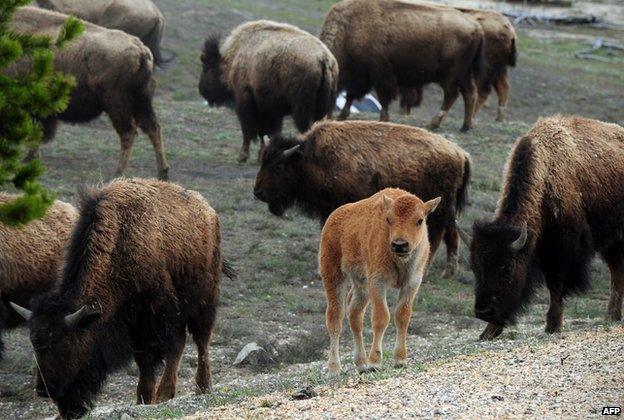Yellowstone supervolcano 'even more colossal'
- Published

Hot springs are surface evidence of the huge magma chamber that sits beneath Yellowstone
The supervolcano that lies beneath Yellowstone National Park in the US is far larger than was previously thought, scientists report.
A study shows that the magma chamber is about 2.5 times bigger than earlier estimates suggested.
A team found the cavern stretches for more than 90km (55 miles) and contains 200-600 cubic km of molten rock.
The findings are being presented at the American Geophysical Union Fall Meeting, external in San Francisco.
Prof Bob Smith, from the University of Utah, said: “We’ve been working there for a long time, and we’ve always thought it would be bigger... but this finding is astounding."
If the Yellowstone supervolcano were to blow today, the consequences would be catastrophic.
The last major eruption, which occurred 640,000 years ago, sent ash across the whole of North America, affecting the planet’s climate.
Now researchers believe they have a better idea of what lies beneath the ground.
The team used a network of seismometers that were situated around the park to map the magma chamber.
Dr Jamie Farrell, from the University of Utah, explained: “We record earthquakes in and around Yellowstone, and we measure the seismic waves as they travel through the ground.
“The waves travel slower through hot and partially molten material… with this, we can measure what’s beneath.”

It is unclear when the Yellowstone supervolcano will erupt again
The team found that the magma chamber was colossal. Reaching depths of between 2km and 15km (1 to 9 miles), the cavern was about 90km (55 miles) long and 30km (20 miles) wide.
It pushed further into the north east of the park than other studies had previously shown, holding a mixture of solid and molten rock.
“To our knowledge there has been nothing mapped of that size before,” added Dr Farrell.
The researchers are using the findings to better assess the threat that the volatile giant poses.
“Yes, it is a much larger system… but I don’t think it makes the Yellowstone hazard greater,” explained Prof Bob Smith.
“But what it does tell us is more about the area to the north east of the caldera.”
He added that researchers were unsure when the supervolcano would blow again.
Some believe a massive eruption is overdue, estimating that Yellowstone’s volcano goes off every 700,000 years or so.

The National Park is a biodiversity hotspot in the continental United States
But Prof Smith said more data was needed, because there had only been three major eruptions so far. These happened 2.1 million years ago, 1.3 million years ago and 640,000 years ago.
“You can only use the time between eruptions (to work out the frequency), so in a sense you only have two numbers to get to that 700,000 year figure,” he explained.
“How many people would buy something on the stock market on two days of stock data.”
In another study presented at the AGU Fall Meeting, researchers have been looking at other, more ancient volcanic eruptions that happened along the same stretch of continental plate that Yellowstone’s supervolcano sits on.
Dr Marc Reichow, from the University of Leicester, said: “We looked at a time window of between 12.5 to 8 million years ago. We wanted to know how to identify these eruptions and find out how frequently they happened.”
The team found there were fewer volcanic events during this period than had been estimated, but these eruptions were far larger than was previously thought.
Dr Reichow added: “If you look at older volcanoes, it helps to understand what Yellowstone is likely to do.”
Follow Rebecca on Twitter, external
- Published13 April 2011
- Published29 July 2013
- Published3 September 2010